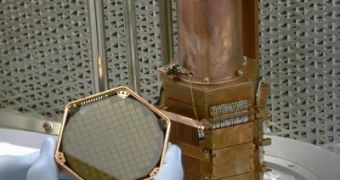The Department of Energy's Fermi National Accelerator Laboratory Cryogenic Dark Matter Search Experiment spokesperson, Blas Cabrera, from Stanford University, claims that their scientists are currently spearheading the search for the best candidates for dark matter. The CDMS experiment is located in a mine in Soudan, and is sensitive enough to detect the interactions between Weakly Interacting Particles and normal matter.
Cabrera says that dark matter particles must be much heavier than the regular elementary described by the Standard Model. In theory, such dark matter candidates could exceed masses 40 times larger than that of the proton.
Current cosmological models argue that only about 4 percent of the total amount of matter in the universe is represented by ordinary matter, while 70 percent is dark matter and another 25 percent is in the form of dark energy. Every second, billions of dark matter particles pass through our bodies. A single fingertip receives more than 100 million particles per second.
Albeit as you can see nothing happens, because dark matter experiences extremely weak interactions with ordinary matter. The first ever candidate for dark matter constituent was the elementary particle, neutrino. However, while CDMS collaborators argue that WIMPs can have masses as high as 100 times that of the proton, the mass of the neutrino remains mostly elusive, and may be a few thousand times smaller than that of the electron's.
It wouldn't be the first time when an elementary particle of a given family is more unusual than the other. The best example is that of the photon; while the photon has no mass, the rest of the virtual particles in the boson family have masses a few times larger than that of the proton. Even with masses as high as 100 times that of the proton, WIMPs interacting with one kilogram of germanium would still collide a few times in the interval of a full year.
The CDMS experiment is strategically located in an underground environment, so that the soil can filter out the energetic particles originating in the cosmic rays and other secondary resultant particles. The detection instrument is placed in a room cooled to 40 milliKelvin. So far, the CDMS experiment hasn't detected a single WIMP, meaning that scientists still have a great deal to learn in relation to the properties of dark matter constituents.
Cosmological observations have routinely shown that dark matter does exist all over the universe, but has failed to provide additional information about this type of matter. Dark matter could have had a great influence over the formation of the first stars, the galaxies and the universe as we know it today.
Additionally, proving that WIMPs exist may bring crucial insight into the models of supersymmetry and demonstrating whether or not extra spatial dimensions exist in the universe, as predicted by the string theory. Fermi Lab physicists are currently preparing the next phase of the experiment which will involve using a quantity of 25 kilograms of germanium, to enhance the discovery potential.

 14 DAY TRIAL //
14 DAY TRIAL //